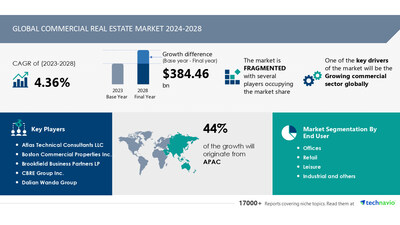
NEW YORK, Dec. 18, 2024 /PRNewswire/ — Report with the AI impact on market trends – The global commercial real estate market size is estimated to grow by USD 384.46 billion from 2024-2028, according to Technavio. The market is estimated to grow at a CAGR of 4.36% during the forecast period. Growing commercial sector globally is driving market growth, with a trend towards increasing marketing initiatives. However, rising emphasis on remote work and online shopping poses a challenge. Key market players include Atlas Technical Consultants LLC, Boston Commercial Properties Inc., Brookfield Business Partners LP, CBRE Group Inc., Dalian Wanda Group, DLF Ltd., Keller Williams Realty Inc., Lee and Associates Licensing and Administration Co. LP, Link Asset Management Ltd., MARCUS and MILLICHAP Inc., MaxWell Realty Canada, NAI , Nakheel PJSC, Onni Contracting Ltd., Prologis Inc., RAK Properties PJSC, Segro Plc, Shannon Waltchack, TCN Worldwide, and WeWork Inc..
Key insights into market evolution with AI-powered analysis. Explore trends, segmentation, and growth drivers- View Free Sample PDF
|
Commercial Real Estate Market Scope |
|
|
Report Coverage |
Details |
|
Base year |
2023 |
|
Historic period |
2018 – 2022 |
|
Forecast period |
2024-2028 |
|
Growth momentum & CAGR |
Accelerate at a CAGR of 4.36% |
|
Market growth 2024-2028 |
USD 384.46 billion |
|
Market structure |
Fragmented |
|
YoY growth 2022-2023 (%) |
4.01 |
|
Regional analysis |
APAC, North America, Europe, South America, and Middle East and Africa |
|
Performing market contribution |
APAC at 44% |
|
Key countries |
US, China, Japan, Germany, and UK |
|
Key companies profiled |
Atlas Technical Consultants LLC, Boston Commercial Properties Inc., Brookfield Business Partners LP, CBRE Group Inc., Dalian Wanda Group, DLF Ltd., Keller Williams Realty Inc., Lee and Associates Licensing and Administration Co. LP, Link Asset Management Ltd., MARCUS and MILLICHAP Inc., MaxWell Realty Canada, NAI Global, Nakheel PJSC, Onni Contracting Ltd., Prologis Inc., RAK Properties PJSC, Segro Plc, Shannon Waltchack, TCN Worldwide, and WeWork Inc. |
Market Driver
In the commercial real estate sector, integrated marketing communication strategies are gaining popularity. Vendors utilize various channels like newspapers, magazines, TV, and social media to sell their products. Creating TV ad campaigns is followed by internet pre-roll, social media, blogging, and interactive websites. Social media, particularly visual content, boosts customer engagement and brand communities. Vendors use Instagram to showcase product ideas and attract customers. The trend of increasing marketing initiatives is expected to fuel the growth of the global commercial real estate market.
The commercial real estate market is experiencing significant changes, with several key trends emerging. E-commerce is driving the demand for larger distribution and fulfillment centers. Manufacturing spaces are also in high demand due to the reshoring trend. Office spaces are adapting to the new normal with flexible work arrangements and increased focus on health and safety. The logistics sector is seeing a surge in demand due to the increase in e-commerce sales. Commercial real estate commissions are expected to increase due to the high demand and competition. Spaces with convenient locations and access to transportation are in high demand. The use of technology is becoming increasingly important in the commercial real estate industry. The market is also seeing an increase in coworking spaces and serviced offices. Smart buildings and energy efficiency are also becoming important trends in commercial real estate.
Request Sample of our comprehensive report now to stay ahead in the AI-driven market evolution!
Market Challenges
- The shift towards online shopping and remote work has significantly impacted the commercial real estate market. Traditional retail spaces and office buildings face decreased demand due to this trend. Businesses are adapting by incorporating co-working spaces, flexible workspaces, and virtual collaboration technologies. This transition challenges the conventional commercial real estate models, particularly traditional office spaces. The focus on e-commerce and remote work may hinder market growth during the forecast period.
- The commercial real estate market faces several challenges in today’s business environment. Economic conditions, commissions, spaces, and technologies are key factors influencing this sector. Economic conditions, such as interest rates and economic stability, impact the demand for commercial properties. Commissions, a significant cost for property buyers and sellers, can affect profitability. Spaces, including office, retail, and industrial, require specific considerations due to changing business trends. Technologies, like virtual tours and online leasing platforms, impact how properties are marketed and managed. Additionally, off-market deals, client relationships, and location are essential elements in the commercial real estate market. Devaluation of assets, vacancies, and competition are other challenges that industry professionals must address.
Discover how AI is revolutionizing market trends- Get your access now!
Segment Overview
This commercial real estate market report extensively covers market segmentation by
- End-user
- 1.1 Offices
- 1.2 Retail
- 1.3 Leisure
- 1.4 Industrial and others
- 2.1 Rental
- 2.2 Lease
- 2.3 Sales
- 3.1 APAC
- 3.2 North America
- 3.3 Europe
- 3.4 South America
- 3.5 Middle East and Africa
1.1 Offices- The offices segment in commercial real estate is experiencing growth due to shifting work trends and corporate needs. Flexible arrangements, hybrid models, and technology usage influence the demand for contemporary, adaptable, and technologically advanced workspaces. Co-working spaces like Regus and WeWork provide flexible solutions, while companies such as Google and Amazon invest in innovative office designs. The offices end-user segment is projected to expand from 2024 to 2028, reflecting the evolving workspace landscape. This transformation offers opportunities and challenges for the global commercial real estate market, leading to moderate growth during the forecast period.
Download a Sample of our comprehensive report today to discover how AI-driven innovations are reshaping competitive dynamics
Research Analysis
In the dynamic commercial real estate sector, businesses in retail and hospitality, as well as boutique operations, are embracing technology to stay competitive. GST implementation and the Smart Cities Mission are driving the adoption of IT solutions, enabling virtual property tours and streamlined lease agreements. Artificial intelligence and technology development are transforming commercial real estate, with smart offices and coworking spaces gaining popularity. Industrial and logistics sectors are also leveraging technology to optimize operations and meet the demands of business owners. The market encompasses conventional offices, multifamily properties, and commercial spaces, offering flexibility for businesses to choose the best fit for their needs. The real estate consultancy sector plays a crucial role in guiding businesses through the complexities of the market, ensuring they make informed decisions on lease, sale, and office space acquisitions.
Market Research Overview
The commercial real estate market encompasses various types of properties used for business purposes, such as offices, retail spaces, warehouses, and industrial buildings. This market is subject to economic conditions, location, and demand factors. Technology plays a significant role in commercial real estate, with smart buildings and virtual tours offering enhanced user experiences. Spaces are designed to be flexible and adaptable to changing business needs. Devaluation of assets is a concern during economic downturns, while vacancies and occupancy rates impact market performance. Offices are transitioning to flexible work arrangements, while retail spaces face challenges from e-commerce. Infrastructure improvements and government policies can influence market trends. Overall, the commercial real estate market is dynamic and complex, requiring in-depth analysis and expertise.
Table of Contents:
1 Executive Summary
2 Market Landscape
3 Market Sizing
4 Historic Market Size
5 Five Forces Analysis
6 Market Segmentation
- End-user
- Offices
- Retail
- Leisure
- Industrial And Others
- Channel
- Geography
- APAC
- North America
- Europe
- South America
- Middle East And Africa
7 Customer Landscape
8 Geographic Landscape
9 Drivers, Challenges, and Trends
10 Company Landscape
11 Company Analysis
12 Appendix
About Technavio
Technavio is a leading global technology research and advisory company. Their research and analysis focuses on emerging market trends and provides actionable insights to help businesses identify market opportunities and develop effective strategies to optimize their market positions.
With over 500 specialized analysts, Technavio’s report library consists of more than 17,000 reports and counting, covering 800 technologies, spanning across 50 countries. Their client base consists of enterprises of all sizes, including more than 100 Fortune 500 companies. This growing client base relies on Technavio’s comprehensive coverage, extensive research, and actionable market insights to identify opportunities in existing and potential markets and assess their competitive positions within changing market scenarios.
Contacts
Technavio Research
Jesse Maida
Media & Marketing Executive
US: +1 844 364 1100
UK: +44 203 893 3200
Email: media@technavio.com
Website: www.technavio.com/
![]() View original content to download multimedia:https://www.prnewswire.com/news-releases/commercial-real-estate-market-to-grow-by-usd-384-46-billion-2024-2028-global-commercial-sector-growth-boosting-market-ai-driving-transformation—technavio-302334048.html
View original content to download multimedia:https://www.prnewswire.com/news-releases/commercial-real-estate-market-to-grow-by-usd-384-46-billion-2024-2028-global-commercial-sector-growth-boosting-market-ai-driving-transformation—technavio-302334048.html
SOURCE Technavio
© 2024 Benzinga.com. Benzinga does not provide investment advice. All rights reserved.



